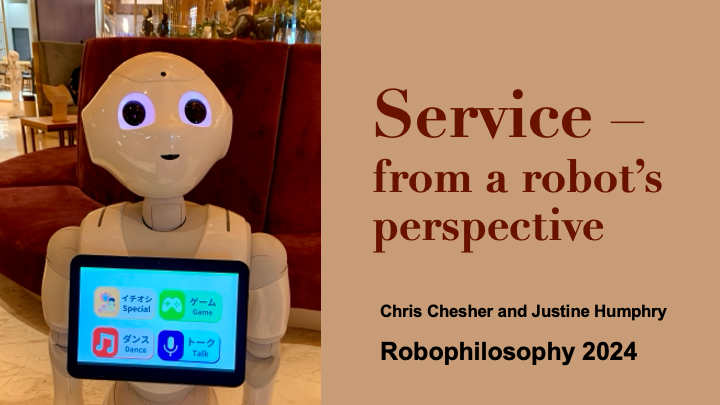Service – from the robot‘s perspective
In this paper, (video below), Chris Chesher and Justine Humphry ask: What does it mean to perform service work as a robot? This question might seem like a thought experiment straight out of a science fiction novel, but it was the starting point for our recent research at the Pepper Parlor, a concept café in Tokyo. Imagine a space where sleek white robots with glowing eyes and twitching movements greet, serve, and entertain customers, offering a vision of the future where human and machine roles blur and converge. But what are these robots really doing—and how do they transform our understanding of service?
In this paper, presented by Chris Chesher at the Robophilosophy conference in Aarhus, Denmark, on 21st August 2024, we explore these questions by stepping into the proverbial shoes (or wheels) of Pepper, one of the café’s humanoid robots. Using a methodology we describe as projective autoethnography, inspired by Raya Jones’ concept of “projective anthropomorphism,” we attempt to imagine and articulate the world from Pepper’s perspective. Our approach draws on ficto-critical techniques—think Kazuo Ishiguro’s Klara and the Sun meets cultural studies—and the philosophical lens of post-phenomenology to unpack the “alterity relations” that unfold between humans and robots.
Robots and Emotional Labor
Central to our analysis is the concept of emotional labor. Traditionally associated with human service workers, emotional labor involves regulating one’s emotions to enhance the experiences of customers, often at great personal cost. From cheerful greetings to empathetic apologies, these performances make dining more than just an exchange of goods—they create meaning, connection, and value.
But can robots perform emotional labor? In the Pepper Parlor, the robots engage in behaviors designed to simulate sociability, from maintaining eye contact to performing dance routines at the push of a button. These scripted interactions are not simply technical feats; they are carefully curated performances meant to evoke warmth and connection. Yet, as we observed, their limitations quickly become apparent. Conversations falter in noisy environments, emotional expressions feel hollow, and the novelty of robotic companionship often fades. This disconnect raises broader questions: How do we as humans interpret these performances, and what do they reveal about our readiness to assign emotional and social meaning to machines?
Service work re-imagined
Our findings also highlight the interplay between robots, their physical environment, and the cultural context of service work. In the Pepper Parlor, the robots’ roles are intricately tied to the café’s “servicescape,” a meticulously designed space that merges technology, aesthetics, and function. Yet, their capacity to deliver service is constrained by technical limitations and the lack of integration with human staff and restaurant operations. Unlike human service workers, who navigate complex interpersonal interactions and adapt to customers’ needs, Pepper’s contributions remain largely symbolic—more spectacle than substance.
At the same time, the presence of robots in service spaces prompts a rethinking of labor itself. Drawing on the work of scholars like Arlie Hochschild and Emma Dowling, we consider how robots might challenge or replicate the dynamics of human emotional labor. Are they merely novelties, or could they alleviate the emotional burdens faced by human workers? Alternatively, are they precursors to a future where service work is further dehumanized, reducing labor to the execution of repetitive tasks?
The future of service
The Pepper Parlor offers a glimpse into an emerging frontier in human-robot relations, but it also serves as a site of tension. Robots like Pepper, Servi, and the more advanced Ameca and Digit present contrasting visions of service automation—one centered on emotional expressiveness, the other on technical efficiency. Each raises its own set of questions: Can robots ever truly “serve” in the same way humans do? What kinds of relationships do they foster, and at what cost?
This research challenges us to critically examine the social, cultural, and ethical dimensions of robotic service work. Rather than simply asking what robots can do for us, we need to consider how their presence reshapes the spaces, practices, and values of service industries. As automation becomes increasingly pervasive, these questions will only grow more urgent.
To delve deeper into our findings and reflections, watch the full presentation embedded below. We hope it sparks further discussion about the complex interplay between technology, culture, and labor in the age of robots.


Leave a Reply